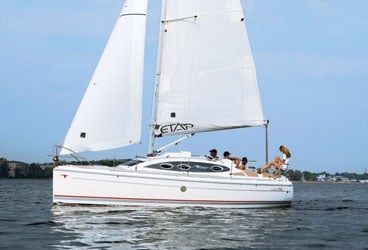
Etap28s 368
On several points, the singular Etap 28s is the most unusual, innovative boat in our lineup. With a distinct, contemporary profile topside and an open, inviting floor plan below, it certainly earns style points for original thinking. But the most radical thing about this newest Etap-and a feature it shares with the five other sister ships, ranging from 21 to 46 feet, in the current Etap line, not to mention all previous Etaps built since 1970-is something that’s not readily apparent to the naked eye: the double-hull construction that renders the boat virtually “unsinkable.”
Etap refers to the building method as “ship-in-ship construction,” which is a very apt description. Basically, every Etap is two boats: twin hulls and decks of solid-fiberglass laminate coupled together with a space in between that’s filled with closed-cell polyurethane foam. The non-absorbent foam is the secret to the process. Should the hull be pierced or otherwise compromised, the boat will remain sufficiently buoyant to stay afloat, even in the event that there’s a large ingress of water. One pays a premium ($138,000) for this level of protection-but the reward is a vessel with supreme waterborne integrity.
There are other, not-so-obvious benefits to the Etap model. For instance, the twin molds afford a high degree of thermal and acoustic insulation, which translates into a quieter, drier (i.e., there’s less condensation) boat. And the hull-within-a-hull sandwich means that the overall structure is particularly rigid and robust.
Now let’s address the things you can see. With its plumb bow and open transom, the 28s takes advantage of nearly every possible inch of available waterline length. The sheer line is nearly straight, and the focal point of the profile view is the Euro-influenced bubbletop coach roof, which is enhanced visually by a series of oval ports and a dark background scheme. There’s not a splinter of wood on deck, though the cockpit seats are enhanced by a faux teak nonskid called Marinedeck that, from a practical standpoint, is very effective. So, too, is the more prevalent gray nonskid on the forward decks. The raised aluminum toerail is cleverly fashioned, but it could also be a safety hazard if someone pinned a foot beneath it.
The rig is a 7/8th fractional number by Seldén with single, swept-back spreaders and the company’s accompanying Rodkicker boom vang. The standard headsail arrangement is a self-tacking 100-percent jib, which is complemented by a partially battened mainsail with generous roach. All reefing lines are led aft to the cockpit, and the mainsheet and traveler are within easy reach of the helmsman, precisely where they should be.
Unfortunately, we sailed the Etap on a day in which the breeze never topped 5 knots, and we couldn’t begin to gauge the boat’s real potential. The 28s would clearly be a lot of fun to drive and easily handled by a solo sailor or a couple. But its high boom, small headsail, and short rig-while no doubt ideal in the windy North Sea and other high-latitude destinations-suggests that it might be underpowered in such light-air venues as the Chesapeake. An overlapping genoa is an option we’d suggest for sailors who cover waters with low-to-moderate breeze.
Below, Italian interior designer Stile Bertone worked wonders with the layout, given the space at hand. With a prevailing theme of arcs and curves, it’s not for everyone, though I found it clean, airy, and very refreshing. Basically, the main saloon, V-berth, nav station, and galley are all one, with two sweeping settees to port and starboard flanking a central table around which all the action flows. At the foot of the companionway, the galley is to port; the nav area and enclosed head are to starboard.
The sole stateroom is aft, with a large, athwartships double berth. The entire interior plan is finished very nicely in light-colored wood, which is offset by the cranberry upholstery and counters. The sensation of space is enhanced by the opening ports and slanted forward hatch, which provide great ventilation, and the central overhead skylight, which offers plenty of natural light. All in all, it’s a cool package.
As a postscript to this story, Etap Yachting was sold in January to German boatbuilder Dehler, adding the Belgian builder’s line of family cruisers to the buyer’s own range of performance-oriented sailboats. This was Dehler’s first expansion since it gained funding from Buchanan Capital Partners, and according to the company, this means that some expansion can be expected at the Etap yard in Malle, Belgium. Etap was founded at that location in 1970 by Norbert Joris.
Herb McCormick is a Cruising World editor at large.
Etap 28s
LOA 28′ 3” (8.60 m.)
LWL 27′ 9” (8.45 m.)
Beam 11′ 3” (3.36 m.)
Draft (shoal) 3′ 7” (1.10 m.)
Draft (deep/standard) 5′ 9” (1.10 m.)
Sail area (100%) 438 sq. ft. (40.8 sq. m)
Ballast (shoal) 2,844 lb. (1,290 kg.)
Ballast (deep) 2,579 lb. (1,170 kg.)
Displacement (shoal) 8,422 lb. (3,820 kg.)
Displacement (deep) 8,157 lb. (3,700 kg.)
Ballast/D .34
D/Length 175
SA/D 16.9
Water 30 gal. (115 l.)
Fuel 17 gal. (65 l.)
Engine 19-hp. Volvo diesel
Designer Von Ahlen Yacht Design
Base Price (sailaway) $138,000
Phone (908) 918-1886
Website www.etap-usa.com








